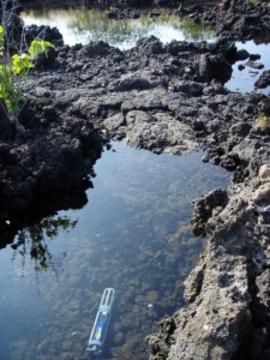Scientists studying anchialine pools in Kaloko-Honokohau National Historical Park on Hawaii’s Big Island recently found an apparently undocumented neritiliid snail species. The discovery of this heretofore unknown marine animal underscores the important role that national parks play in helping to preserve Hawaii’s globally rare habitats and advancing our knowledge of their fascinating ecology.
The small bodies of still water that we call pools are found in many locations and exist in many forms –stream, plunge, tidal, hydrothermal, vernal, and so forth. One of the more interesting types is the anchialine pool (pronounced AN-key-ah-lin), a small land-locked body of fresh or brackish water that has a subterranean connection to the ocean, but no surface connection. Because pools of this type are characteristically located near the shoreline (anchialine is Greek for “near the sea), their water levels commonly fluctuate with the tides.
Anchialine pools are much more numerous and widely distributed than most people realize. Thousands can be found along coasts around the world. They are especially abundant in neo-tropical areas that have thin soils and bedrock composed of solution-weathered limestone or volcanic rock of recent origin. Anchialine pools are very common in the karst landscape of Mexico’s Yucatan Peninsula, where they occupy sea-connected sinkholes called cenotes, and in Hawaii, where coastal aquifers have formed within basalt layers built up by shield volcano lava flows. Hawaii has the world’s greatest concentration of anchialine pools.
On the Big Island (Hawai’i), most pools of this type are found on the west coast, which includes the famed Kona Coast resort area. One Kona Coast locale where pools of this type are very abundant is Kaloko-Honokohau National Historical Park, a 1,160-acre national park established in 1978 to preserve fishponds, petroglyphs, religious sites, and other historically significant cultural resources associated with an ancient Hawaiian settlement. An ecological study conducted at Kaloko-Honokohau in the late 1990s confirmed that there are at least 82 anchialine pools in and near the park.
Some scientists find anchialine pools like those at Kaloko-Honokohau endlessly fascinating because they are home to interesting fish, mollusks, and crustaceans. Some of these species are abundant, a good example being Halocaridina rubra, the little red shrimp that native Hawaiians named the ʻōpaeʻula. Others are regionally or globally rare species, including some that exist nowhere else on Earth. Hawaii is famous for its endemic species -- about two-thirds of Hawaii’s native species are unique to the islands -- and anchialine pools are great places to look for them.
Recently, scientists studying brackish anchialine pools at Kaloko-Honokohau National Historical Park found specimens of two different neritiliid snail species that are remarkably rare. One was a species that had previously been recorded only by cave divers in Kona Coast submarine caves. The other, which generated even more excitement, was a snail species that had been apparently never been documented before.
This possible new species is a member of the Neritiliidae family of small gastropod mollusks, which is represented by thousands of species inhabiting tropical marine and fresh water habitats worldwide. Whether this find at Kaloko-Honokohau represents a species new to science awaits official confirmation.
Postscript: The Kaloko-Honokohau National Historical Park’s anchialine pools and their inhabitants, including the rare neritiliid snails, are exposed to serious threats in the form of sea level rise and development-related groundwater withdrawal. Either hazard is capable of seriously degrading or destroying some of the pools.




Comments
Can you point me to any more recent information about the possible new species of Neritiliidae snail?
aloha, Barb
I'm sorry, BarbM, but I can't pursue additional information about the Neritiliidae snail. We are just too overworked and understagged here at the Traveler to take on projects like that.